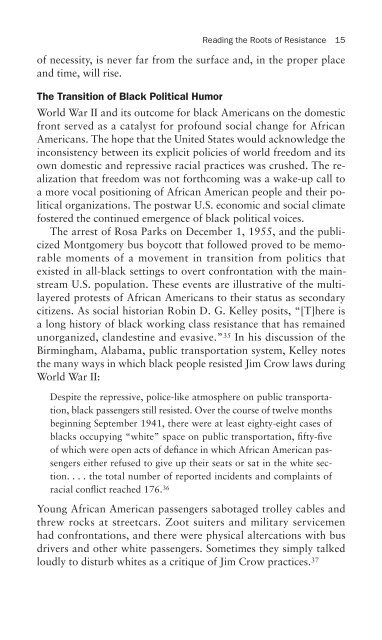Revolution Televised.pdf
Revolution Televised.pdf
Revolution Televised.pdf
Create successful ePaper yourself
Turn your PDF publications into a flip-book with our unique Google optimized e-Paper software.
Reading the Roots of Resistance 15<br />
of necessity, is never far from the surface and, in the proper place<br />
and time, will rise.<br />
The Transition of Black Political Humor<br />
World War II and its outcome for black Americans on the domestic<br />
front served as a catalyst for profound social change for African<br />
Americans. The hope that the United States would acknowledge the<br />
inconsistency between its explicit policies of world freedom and its<br />
own domestic and repressive racial practices was crushed. The realization<br />
that freedom was not forthcoming was a wake-up call to<br />
a more vocal positioning of African American people and their political<br />
organizations. The postwar U.S. economic and social climate<br />
fostered the continued emergence of black political voices.<br />
The arrest of Rosa Parks on December 1, 1955, and the publicized<br />
Montgomery bus boycott that followed proved to be memorable<br />
moments of a movement in transition from politics that<br />
existed in all-black settings to overt confrontation with the mainstream<br />
U.S. population. These events are illustrative of the multilayered<br />
protests of African Americans to their status as secondary<br />
citizens. As social historian Robin D. G. Kelley posits, “[T]here is<br />
a long history of black working class resistance that has remained<br />
unorganized, clandestine and evasive.” 35 In his discussion of the<br />
Birmingham, Alabama, public transportation system, Kelley notes<br />
the many ways in which black people resisted Jim Crow laws during<br />
World War II:<br />
Despite the repressive, police-like atmosphere on public transportation,<br />
black passengers still resisted. Over the course of twelve months<br />
beginning September 1941, there were at least eighty-eight cases of<br />
blacks occupying “white” space on public transportation, fifty-five<br />
of which were open acts of defiance in which African American passengers<br />
either refused to give up their seats or sat in the white section.<br />
. . . the total number of reported incidents and complaints of<br />
racial conflict reached 176. 36<br />
Young African American passengers sabotaged trolley cables and<br />
threw rocks at streetcars. Zoot suiters and military servicemen<br />
had confrontations, and there were physical altercations with bus<br />
drivers and other white passengers. Sometimes they simply talked<br />
loudly to disturb whites as a critique of Jim Crow practices. 37

















